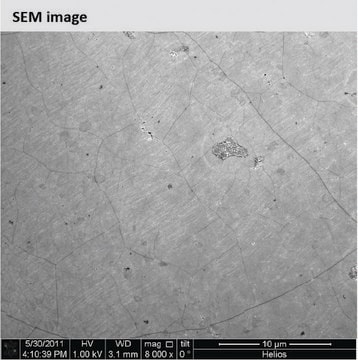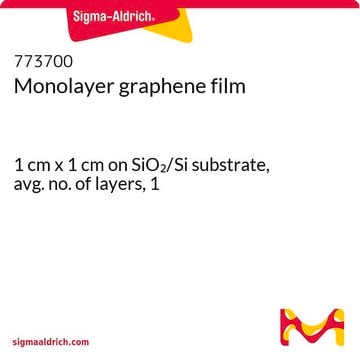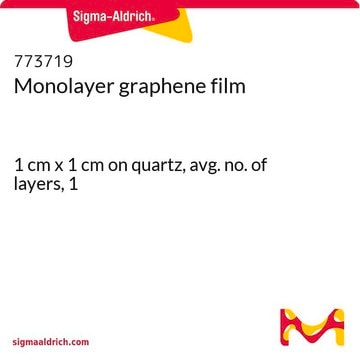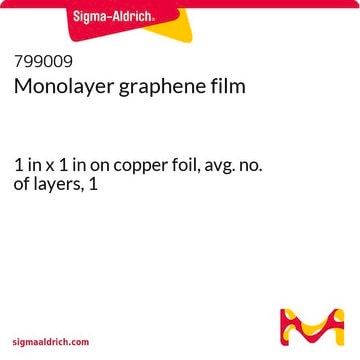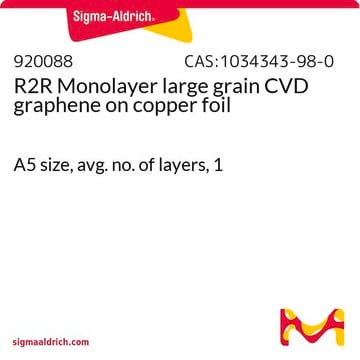GRTRANSFER25
Easy transfer monolayer Graphene
L × W 1 in. × 1 in., avg. no. of layers, 1
About This Item
Produits recommandés
Caractéristiques
avg. no. of layers 1
Mode de croissance
CVD
Résistance de la couche
450 +/- 40 Ω/sq, on SiO2/Si (1cm x 1cm)
L × l
1 in. × 1 in.
Couverture de surface
>98%
Couleur
transparent>97%
Granulométrie
≤20 μm
Vous recherchez des produits similaires ? Visite Guide de comparaison des produits
Catégories apparentées
Description générale
Structure of the easy-transfer graphene:
Top sacrificial layer (square shaped), CVD monolayer graphene in the middle, and bottom water-releasable polymer support layer (round shaped)
Application
This product employs a specially designed mechanism for easy and clean transfer of high quality monolayer CVD grown graphene to build state-of-art electronic devices such as:
- Graphene based state-of-art FET
- Graphene based sensors
- Heterostructure based micro/nano electronics
Clean tranfer can be done following below 3 easy steps:
Release
Put the sample on deionized(DI) water slowly, round side (polymer layer) facing down, the square-shaped sacrificial layer+graphene will gradually detach from the rorund polymer film. Once the sacrificial layer/graphene is floating remove the round polymer film.
Transfer
Bring the desired substrate into the same DI water container while the sacrificial layer/graphene is floating. Tilt the substrate 45º and bring it into contact with the sacrificial layer/graphene from below. Take the sacrificial layer/graphene/substrate out and let it dry for 30 minutes in air. Then anneal the samples on a hot plate at 150 Celsius for 1h. Finally, before removing the sacrificial layer, store it under vacuum for at least 24h to avoid detachment of the graphene from your substrate.
Sacrificial layer Removal
To remove the sacrificial layer two methods can be used:
Solvents: Dip the sacrificial layer/graphene/substrate in acetone for 1h, then into isopropyl alcohol for another 1h and blow the sample with N2 to dry it.
Thermal treatment: Put the sacrificial layer/graphene/substrate into an oven and heat the sample at 450 C in
inert atmosphere for 2h.
Code de la classe de stockage
11 - Combustible Solids
Classe de danger pour l'eau (WGK)
WGK 1
Point d'éclair (°F)
Not applicable
Point d'éclair (°C)
Not applicable
Certificats d'analyse (COA)
Recherchez un Certificats d'analyse (COA) en saisissant le numéro de lot du produit. Les numéros de lot figurent sur l'étiquette du produit après les mots "Lot" ou "Batch".
Déjà en possession de ce produit ?
Retrouvez la documentation relative aux produits que vous avez récemment achetés dans la Bibliothèque de documents.
Articles
Review on 1D vdWHs: Discusses materials, synthesis, optoelectronic applications, challenges, and future perspectives for 1D vdWH-based devices.
Notre équipe de scientifiques dispose d'une expérience dans tous les secteurs de la recherche, notamment en sciences de la vie, science des matériaux, synthèse chimique, chromatographie, analyse et dans de nombreux autres domaines..
Contacter notre Service technique